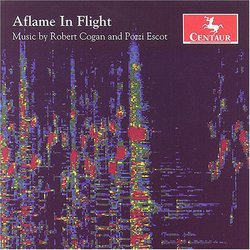| All Artists: Robert Cogan, Pozzi Escot, Jacques Monod, New Events Ensemble, Jon Sakata, Bethany Beardslee, Jennifer Ashe, Joan Heller Title: Aflame in Flight: Music by Robert Cogan and Pozzi Escot Members Wishing: 0 Total Copies: 0 Label: Centaur Original Release Date: 1/1/2005 Re-Release Date: 11/29/2005 Album Type: Import Genres: Pop, Classical Styles: Vocal Pop, Chamber Music, Historical Periods, Classical (c.1770-1830), Modern, 20th, & 21st Century Number of Discs: 1 SwapaCD Credits: 1 UPC: 044747272221 |
Search - Robert Cogan, Pozzi Escot, Jacques Monod :: Aflame in Flight: Music by Robert Cogan and Pozzi Escot
 | Robert Cogan, Pozzi Escot, Jacques Monod Aflame in Flight: Music by Robert Cogan and Pozzi Escot Genres: Pop, Classical |
Larger Image |
CD Details |
CD ReviewsAflame In Flight: Music by Robert Cogan and Pozzi Escot Matthew Warnick | Vero Beach, FL USA | 04/20/2006 (5 out of 5 stars) "
AFLAME IN FLIGHT, New CD released November 1, 2005 with music of composers Robert Cogan and Pozzi Escot Cogan's Aflame in Flight (1999-) for solo violin with vocals, also performed by the violinist, is another in the composer's "folio" forms of composition where the performer chooses from individual sections and orders them to create movements and thus the work in its entirety. The text is taken from Paterson by William Carlos Williams and it functions as a narrative. At times the violin imitates the "fire-like language" with a frenzied style but during silences in the text, the violin takes on a melodic character. This cycle comes to an end and the process begins again imitating the endless flow of the Passaic River to the sea. American French violinist Michael Appleman performs with power and virtuosity. The next piece, Celan Portrait/Celanportrat (2003-) for soprano and piano is just that -- a portrait of the poet Celan. Cogan uses texts from no less than six poems mixed together in both English and German. There is an abundance of elements that function as constants and others that speed up throughout the five movements. The piano scoring starts with registral layers, then proceeds through repeated notes originating in chords, to arpeggios and a climax of multiple attacks and tremolos in the final movement. There are pauses within the movements which signify a change from slower English text to suddenly fast German text. This work is also a folio piece which will provide different patterns of the piano textures and the voice lines. Here the performance with soprano Joan Heller and pianist Jon Sakata is thrilling. Escot's Three Poems of Rilke/4th String Quartet (1959) sets "The Poet", "World was in the face of the beloved", and "End Piece", performance by the Claremont String Quartet and composer Hugo Weisgall reciting the texts. The piece is very time-sensitive to the ratio 1:2 at all levels, as can be seen by the duration of the three movements: 4:24, 2:00 and 1:02, each 1/2 the duration of the previous one. It begins with a crescendo of 62" followed by another crescendo of 62" which finally introduces the recitation. Sonically, the reciting is almost mechanically steady, to which the instruments join in. The voice takes over in the final movement with an opening crescendo with strings and voice coordinated one time through the text. The quartet ends with a repetition of the verse with a decrescendo not synchronized on the English words, "enormous death" (Tod Gross ist). Escot's Lamentus (1962) is the first chamber piece of the "Trilogy for the Six Million" scored for a chamber group with soprano and percussion. The piece has a distinctly sparse texture which makes it easier to hear the individual tone-colors of the ensemble. The percussion changes tempo almost continuously, and in contrast the voice follows an even tempo. The voice text is simple tone-colors, again in contrast to the "noise" of the percussion. This sets up a multitude of oppositions that are blended with the use of tubular bells and gongs which climax in Movement IV, leaving the next Movement V to act as the finale. The heart and soul of this composition is the extremes of time, space, and tone-color. The last piece on this CD is again by Escot, Aria I (1998) for soprano, flute, clarinet, and saxophone. Durations play a key role as they always do in Escot's compositions. The first silence is at 17" followed by again 17" of music for a total of 34". The next silence starts 17" later but only lasts 4". However, this is at 55", setting up an interesting transition to Fibonacci series (34" + 21" [17+4] = 55"); and again 21" between beginning and ending of the next silence. Finally there is a saxophone climax. The beginning of the piece is rough and disjointed. Ironically, the silences add to the disjointedness. After the over-blown dissonance, the remainder of the piece gradually merges into unisons and quiet tone colors, completing its drama at the opposite end of the spectrum from where it started. Master composers Pozzi Escot and Robert Cogan, along with superb performers, have both contributed to deliver a breathtaking recording. The pieces span several decades (1959-2003), but up to, and including, the title track "Aflame in Flight" by Cogan, all show a consistent exploration of artistic genesis. " |
